
Every city has a tale or two to tell, and every worthwhile tale demands a storyteller. For the city of Burlington, Vermont, that storyteller was renowned photographer Louis L. McAllister. McAllister chronicled the city of Burlington and its inhabitants for the better part of his lifetime. With his camera, he recorded the evolution of the city at the dawning of a new age. Through two world wars, decades of progress, and periods of struggle, McAllister bore witness to a large swath of Burlington’s transformation as it grew from a small community into a bustling, modern center of commerce. His life’s work left behind the most complete photographic study of life in Vermont’s Champlain Valley during the twentieth century. Under his watchful eye, Burlington matured and became Vermont’s most populated city.
Beginning in 1823, when the city of Burlington was still just a town, the completion of the Champlain Canal finally connected Lake Champlain to the Hudson River in New York. This development was a crucial step for the area’s growth, economy, and industry. Success in the Champlain Valley was so great that by the latter half of the nineteenth century, Burlington, Vermont claimed its place among the nation’s top lumber ports. In the following decades, while the Burlington waterfront and industry at nearby Winooski Falls expanded, the area buzzed with people. The lumber industry, commerce, and the population of Burlington enjoyed sustained growth. An 1830 map of Burlington, drawn by Ammi B. Young illustrates Burlington as it existed prior to the Industrial Revolution.1 With time, industrialization and improved transportation infrastructure connected Vermont to the wider nation and the world beyond.
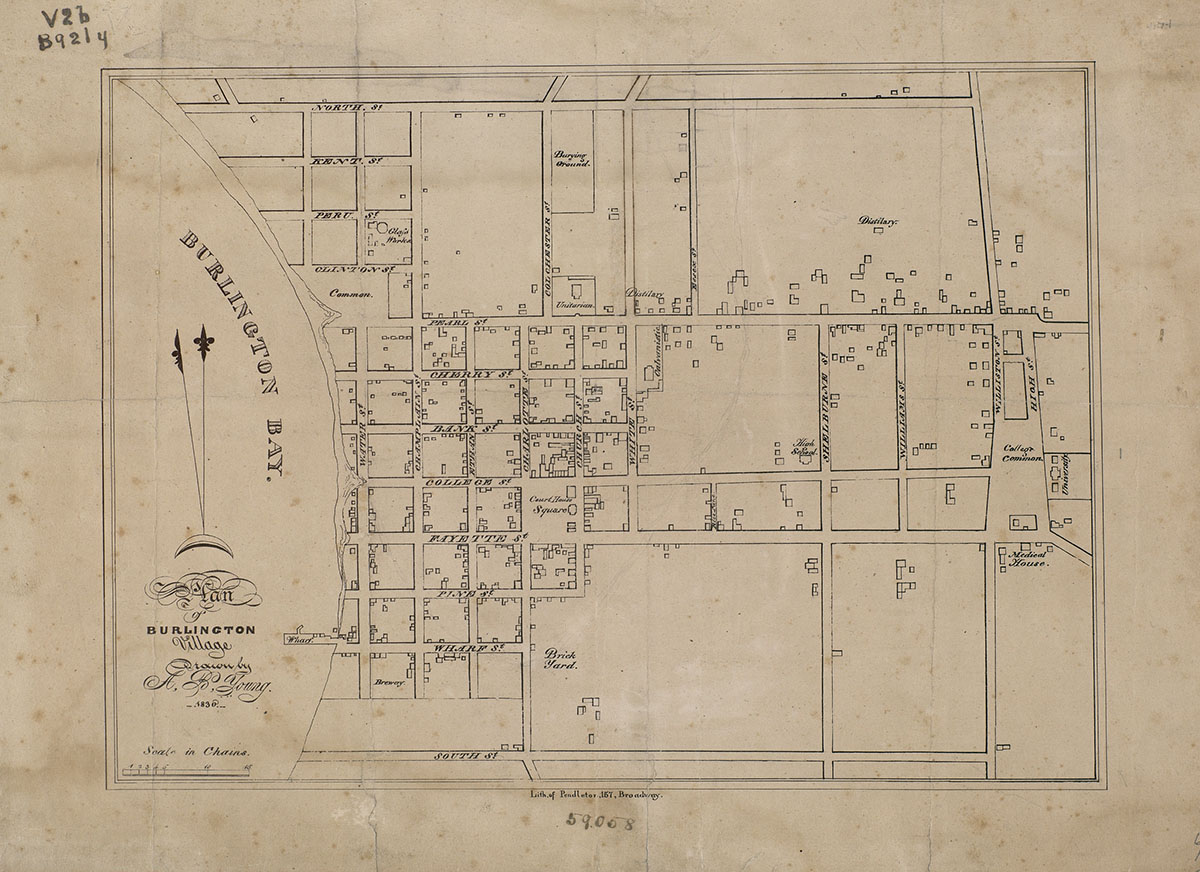
However, progress, industry, modernity and unprecedented growth came at a high price. Even as the economy grew, and the nation expanded, it was being torn apart from within. The political, economic, and civic forces that came together in the middle of the nineteenth century threatened to destroy everything that the young nation had built. The Civil War took its toll, even within the northern reaches of the state of Vermont. According to records held by the state, “one in every nine Vermonters joined in support of the Union Army. Over the span of a few years, as many as 34,000 soldiers enlisted, and by the War’s end more than 5,224 died of wounds or sickness.”2 The loss was extraordinary. Suffering touched people on every level of social strata. After the Civil War, Vermonters returned to their way of life, all the while cautiously playing an ever-increasing role in the world around it. At the heart of that modern effort was the city of Burlington and Church Street.

Situated midway between the waterfront and the hill that is home to the University of Vermont’s main campus, Church Street was ideally located within walking distance of several Burlington and Winooski neighborhoods. What began as a residential dirt road full of modest, wood framed houses slowly morphed into a social and commercial hub that served several of the surrounding communities. Church Street became a center for congregation, celebration and beauty that is still enjoyed to this day. In his book, Picturesque Burlington: A Handbook of Burlington, Vermont and Lake Champlain, author Joseph Auld described Burlington as “a place for sensible, reasonable people… it contains more possibilities of good health, pleasure and genuine good living than many another place with greater pretensions.”3
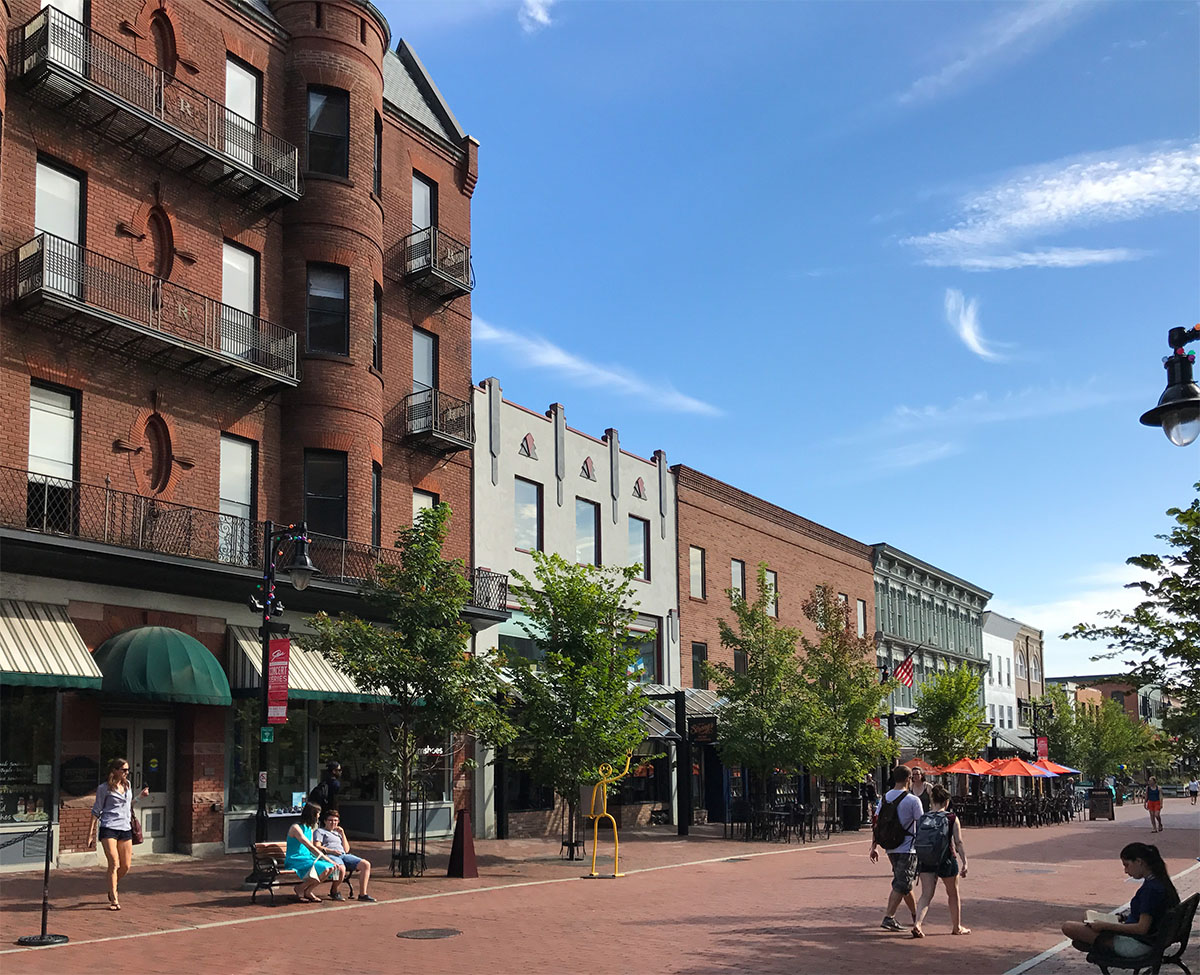
Four city blocks run north to south and house an eclectic collection of structures including businesses, churches and municipal buildings. The Upper Block of Church Street, the location of Burlington’s iconic Unitarian Church, the Masonic Temple and Abernethey’s towering Department Store, was first nominated to the National Register of Historic Places in the summer of 1976. Through the later half of the century a large-scale effort to return Church Street to its original use as a pedestrian thoroughfare came underway. During the implementation of those plans, the street was laid with brick pavers and sections of Church Street were gradually closed off to vehicular traffic. The Top Block, from Pearl Street to Cherry Street, was the final portion to be closed off. By and by, several local businesses, a few major retailers, and a variety of novelty stores, restaurants and cafes filled the street. The transition was a highly successful and the economic returns soon became evident. Thanks to the achievements of the new marketplace and the preparation that went into restoring many of the structures, the remaining contributing blocks of Church Street were also nominated to the National Register of Historic Places in 2010.
Numerous buildings contribute to the Upper Block of Church Street, which is bound to the north by Pearl Street and to the south by Cherry Street. Traditionally, due to the nature and use of these structures, each of the buildings were referred to as “blocks” and each block had its own name and distinct characteristics. The buildings were typically constructed out of brick and were built to accommodate one or more storefronts on the ground level. These ground level storefronts boasted everything from modest hand painted signs, to colorful advertising. Most had large window displays and many of the storefronts were punctuated by awnings and prominent lampposts. The uppermost floors of each building were often reserved for office spaces and apartments that could be used by the owner or rented out to tenants.
The mid-block, on the eastern side of Church Street, consists of a group of seven buildings. Examining the history of these seven buildings and their relationship to Church Street will provide better context to understanding Burlington’s most famous street, Vermont’s largest city and some of the changes that have left the greatest impact on Vermont through its long history. Beginning immediately after the Abernethy Department store, the contemporary addresses for this set of buildings runs from #10 Church Street to #32 ½ Church Street. The inconsistent numbering on this section of buildings is one small indication to the degree of change that has taken place on this section of Church Street over the years. Each of these structures offers a unique façade and illustrate a myriad of styles that were popular in architecture throughout the late nineteenth and early twentieth centuries. Although they have passed through several hands and in many cases, been remodeled since their conception, overall, most of the buildings remain complimentary to the vision originally set out for them. The structures range in elevation from two to three stories and range in style from Art Deco, Italianate, Classical Revival, Greek Revival, and International styles. Together they create a very pleasant and colorful eclectic passage.
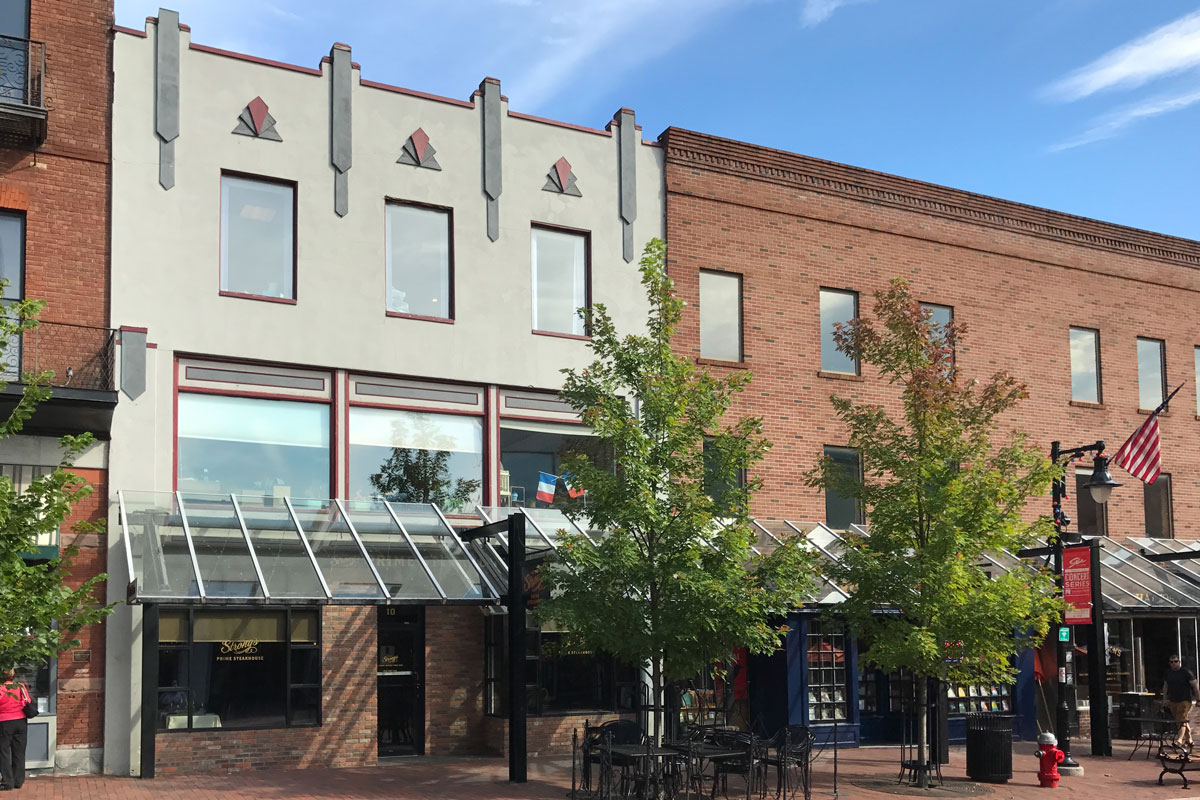
#10 Church Street
An 1877 Birdseye map of Burlington shows an intricately detailed artist’s rendition of the primarily residential downtown area.4 During the antebellum years, Church Street housed handful of buildings including a few specialty shops, gardens, homes, and local markets. The Sanborn Fire Map from 1869 illustrates the placement of these structures. Sporadically spaced, the only buildings that occupied the eastern portion of the mid-block of Upper Church Street were 10 Church Street, a small market around 20 Church Street, a modest paint shop near 28 Church Street, and a private residence near 30 Church Street.5

The attractive building that is today known as #10 Church Street was constructed in 1877. Prior to construction, that same plot of land housed the personal library of local legend, George Perkins Marsh.6 Educated at the prestigious Dartmouth College, Marsh was well-respected scholar, lawyer, and congressman. He was also a pioneer in the emerging field of conservation, an endeavor that developed into an important practice for generations of Vermonters. Marsh’s library collection was a treasure trove of information and was so large that he housed it independent from his property, in a small building at #10 Church Street. Upon his death in 1881, his library collection was acquired by another beloved Vermont native, Frederick H. Billings.
Frederick Billings was also an accomplished lawyer and businessman who made his fortune in real estate out West, following the Gold Rush of 1849. The two men’s lives collided when after Billings was enchanted by the landscapes of the Yosemite Valley of California.7 These experiences led him to the writings of conservation giant George Perkins Marsh and propelled Billings into a life dedicated to service. He endeavored to save Vermont’s natural spaces and local economies through prudent management and preservation methods. Later in his life, Billing’s donated the Marsh collection to the University of Vermont, his alma mater, where it remains in safe-keeping.
Prior to both the construction of Marsh’s private library and the contemporary edifice #10 Church Street, the plot contained a smaller structure. An 1862 map indicates that the land once housed a private office.8 However, as it stands, the current edifice at # 10 Church Street was built in 1877 for Mr. Hoyt E. Salls.9 Through the turn of the twentieth century the building served as retail space and housed a variety of commercial enterprises including a millinery and an arts and crafts store.10 In 1936, the façade was remodeled to match the vision of the savvy businessman, Frank D. Abernethy, owner of Abernethy’s Department Store, next door. Upon completion of the innovative Art Deco remodel, Abernethy opened Abernethy’s Men’s Shop, a supplementary store to his flagship corner location.
Abernethy’s vision for the design of the building was timely as well as unique. According to the Church Street Historic District National Register Nomination, the building remains one of only a few significant examples of Art Deco buildings in Vermont.11 The distinct façade can be glimpsed in a photograph taken by Louis McAllister on June 25, 1943. The photograph shows colored awnings projecting from various store fronts, a line of mid-century motor cars parked on each side of the street, towering, two-story iron lampposts and shoppers taking in the sights.12 Presently #10 Church Street’s storefront shop is currently home to E. B. Strong’s Prime Steak House Restaurant. The restaurant is an upscale establishment that has served the local community for more than 30 years.
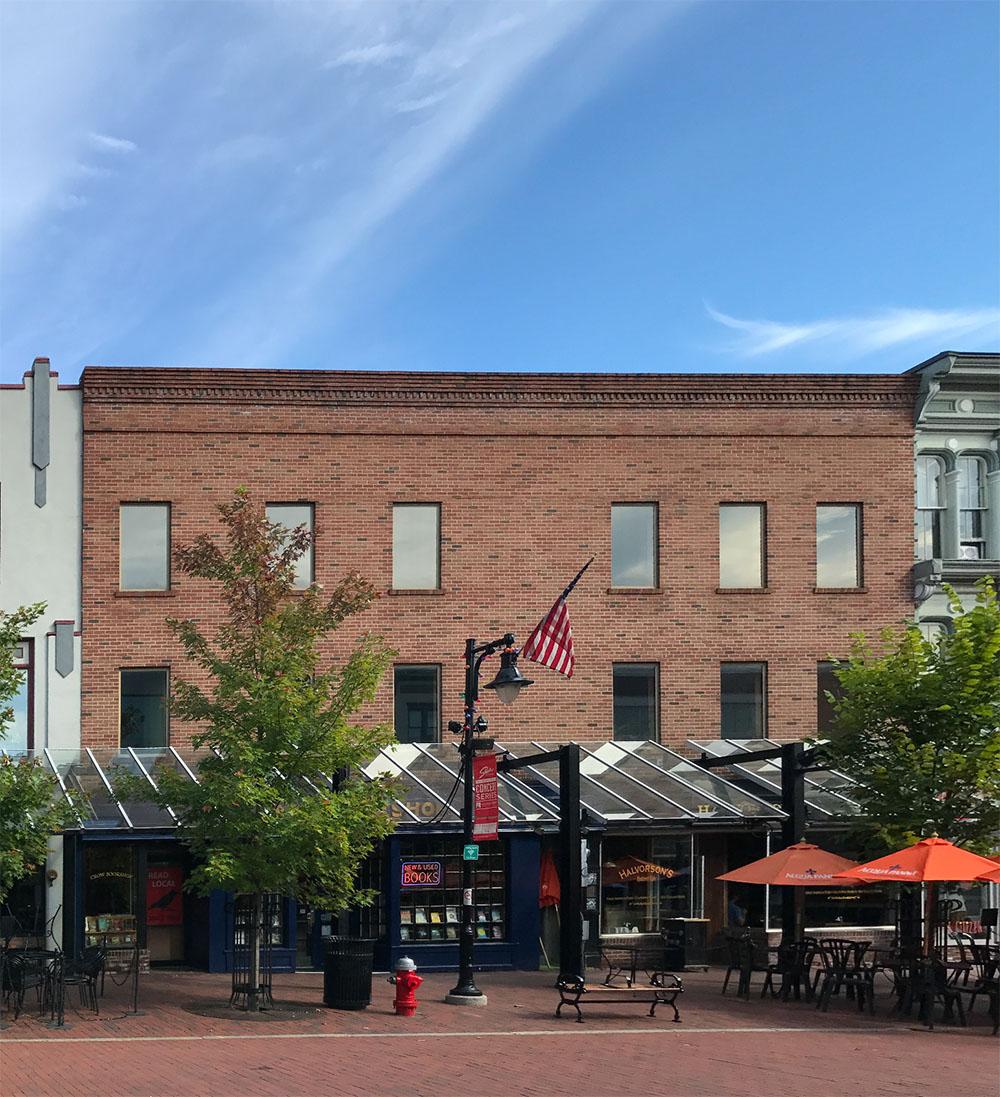
#14- 16 Church Street
Working south, on the eastern side of Church Street, the next building encompasses #14- 16 Church Street. This building has a three-story brick façade of #14 – 16. Built in 1872, the structure was formerly a delicate six-bay Italianate structure. The original façade was memorialized in a postcard of a parade on Church Street, taken around mid-century. Construction on the site began in 1873, when the property was purchased by Joseph Chauvin.13 This shop block was referred to as “Chauvin’s Block” due to the building’s wealthy benefactor. Chauvin had the building designed in the same mixed-used style as many of its neighboring buildings. Once construction was complete, Chauvin himself lived in the residential space in the upper floors and he and leased the ground floor space out until 1870s. Through the following decades and into the early 1900s, George W. Kelley ran his grocery store from that address.
By 1889, another Sanborn Fire Map was created, and it confirmed the growth of Burlington as a city and Church Street as a destination for locals and visitors alike. Much more densely populated that just sixteen years prior, the mid-block of Upper Church Street began to fill in quite nicely.14 The gardens that were once dispersed throughout Church Street properties all but disappeared and progress took their place. From markets to barber shops, billiards to a photography shop, there was a service to anticipate every need of the growing community.
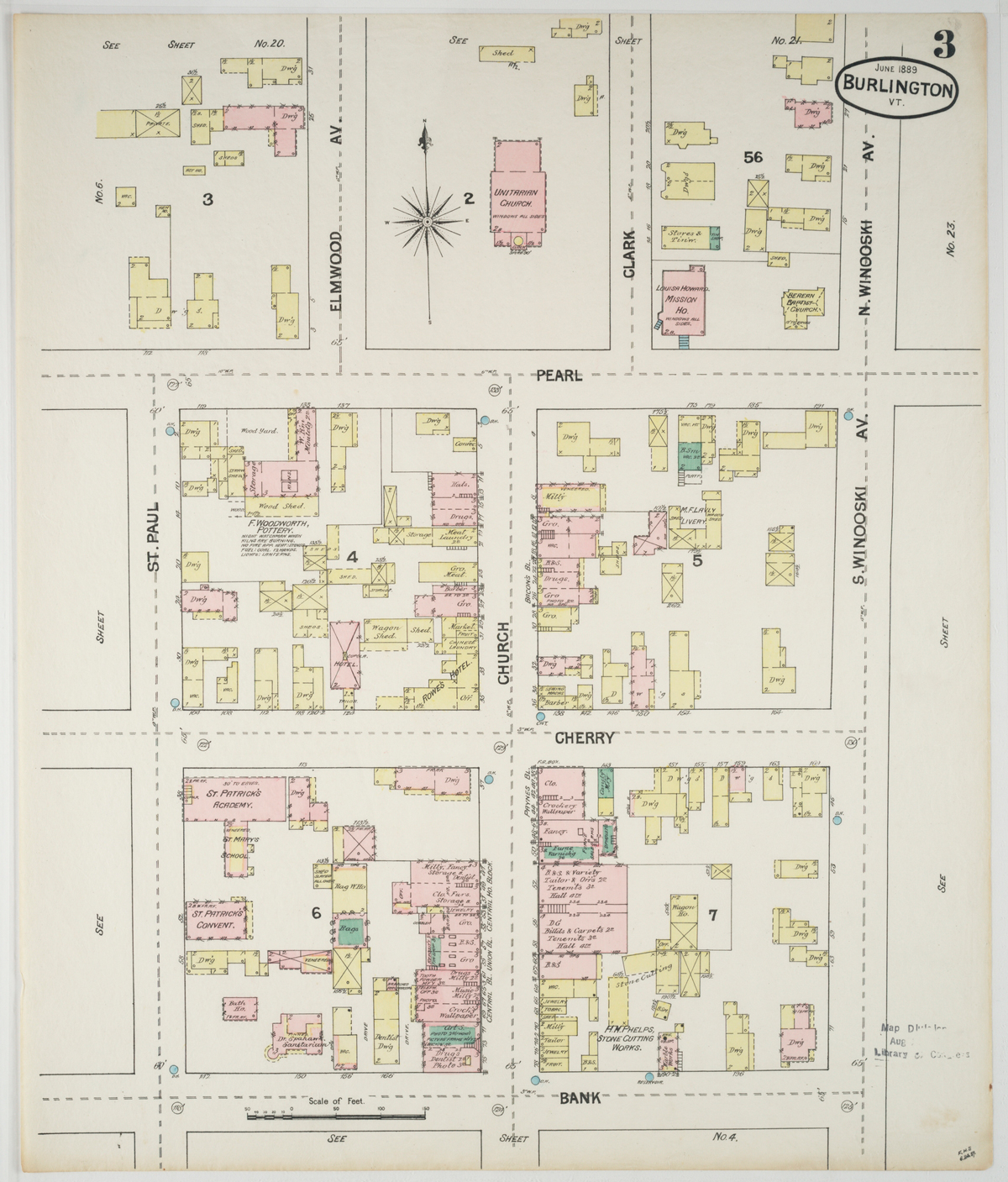
By 1900, a single-bay building was added onto the north side of #14 Church Street by architect Louis Xavier Fremau. Fremau constructed the addition to house a jewelry shop for his father, noted jeweler, Louis Fremau. An article published in the Burlington Free Press from February of 1923 described the established family and their renowned jewelry business.15 This addition, together with the 1873 edifice constituted what the National Register nomination quantified as “one of the first commercial blocks on the northern end of Church Street.” In the following years the commercial block plan was repeated with great success all the way through Church Street.
As time marched on, the building changed hands and served a variety of consumer needs. From 1912, the southernmost shop in the block housed something rather remarkable, the new Casino Theater.17 That year the Burlington Free Press announced that exciting and revolutionary technology would bring motion pictures to Church Street.16 Imagine the spectacle! At a time when many homes in Vermont still lacked indoor plumbing and electricity, motion pictures were available to be enjoyed on Church Street. But for all its glamour, the life of Casino Theater was short lived. According to an advertisement in the Burlington Free Press from March 18, 1916 the theater was up for sale because the owner was “going out of showbusiness.”18
Unfortunately, the original facade suffered damage in a fire in December of 1983. The second and third floors of the building were heavily damaged. The current brick façade of the building is a result of post-fire reconstruction. While plain, the restrained facade still manages to compliment the buildings which surround it.19 Presently, the ground level of #14 Church Street boasts a lovely independent bookshop called Crow Bookshop and #16 Church Street is home to Halverson’s Upstreet Café. Over time Halverson’s has earned a reputation not only for its delicious food, but equally for hosting live, local music on the weekends.
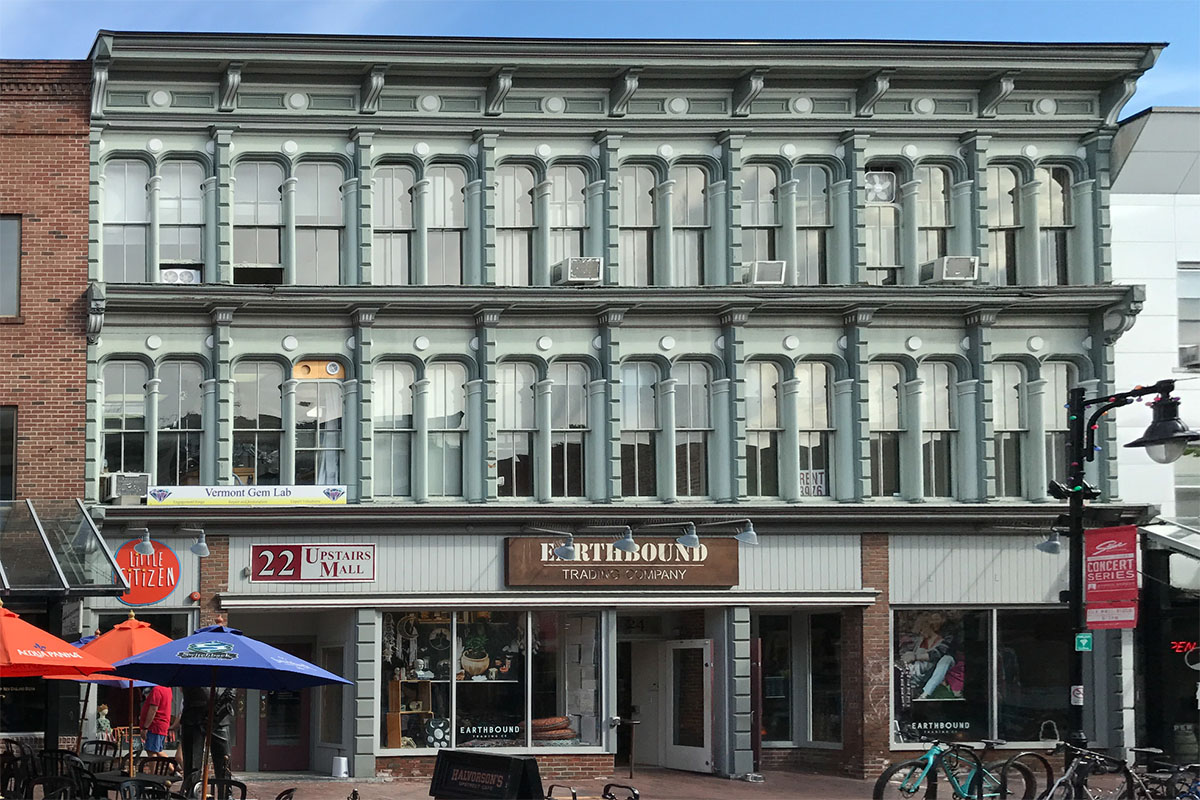
#20–24 Church Street
Constructed in 1874, the edifice once known as “Bacon’s Block” at #22 Church Street is an attractive example of high style, Italianate architecture. The muted blue-green color of the building’s façade is immediately recognizable. The building’s two upper stories, filled with large windows, face Lake Champlain and catch early evening light as the sun sets each day on Church Street. The building’s striking design was the vision of the talented E. C. Ryder for local developer, Nelson Bacon.20 A Burlington Free Press article from July 22, 1874 described the construction of the new building in vivid detail. “The edifice is universally acknowledged to be an ornament to the city, and creditable alike to owner, architect and builders.”21 The article goes on to describe the businesses that were to reside in the striking new structure. Among the occupants on the first floor were Mr. M. V. B. Weeks, a dealer in boots and shoes, a fancy goods store, and a grocer.22 The remaining spaces in the upper floors of the building were rented out as apartments. Such a dynamic combination of businesses in one building revealed the developing consumer interests the of residents of Burlington. Living essentials and groceries were not the only things that interested the visitors to Church Street. Shoppers were considering new consumer trends and were keen to explore innovative hobbies like film and photography.
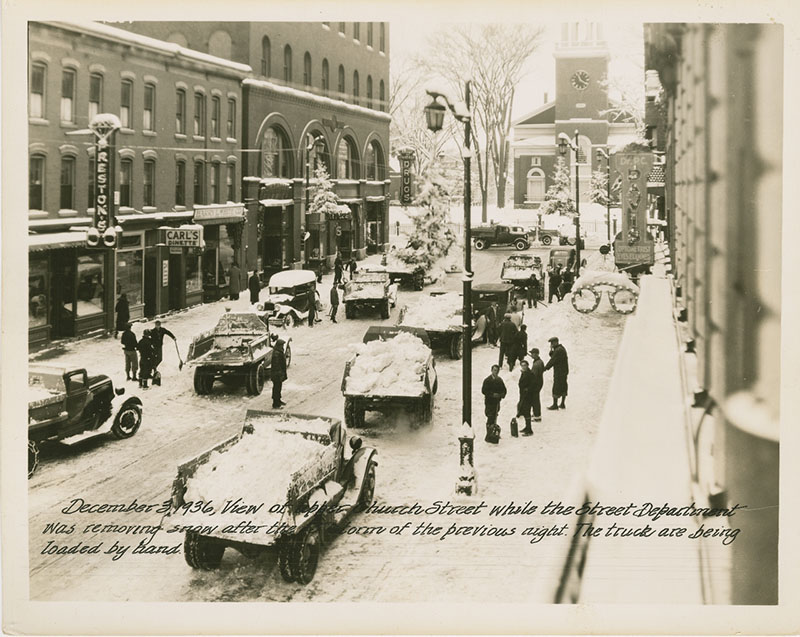
Photographer Louis McAllister captured a lively scene at this address on December 3, 1936.23 Taken from a second story window, the photograph shows store fronts with their individual signs, the Top Block of Church Street packed with cars, trucks, and pedestrians. The hand-written caption further explains that the Burlington Street Department was attempting to clear Church Street of a freshly fallen blanket of snow. Although locals and visitors alike will all agree that Church Street is lovely in any season, it has a particularly magical quality when it is dressed in white through the winter months. Today, the building at #22 remains true to its origins. Bacon’s Block still maintains its prominent historic façade and continues to house an eclectic collection of novelty shops such as Little Citizen, Earthbound Trading Company, medical and commercial offices as well as apartments.
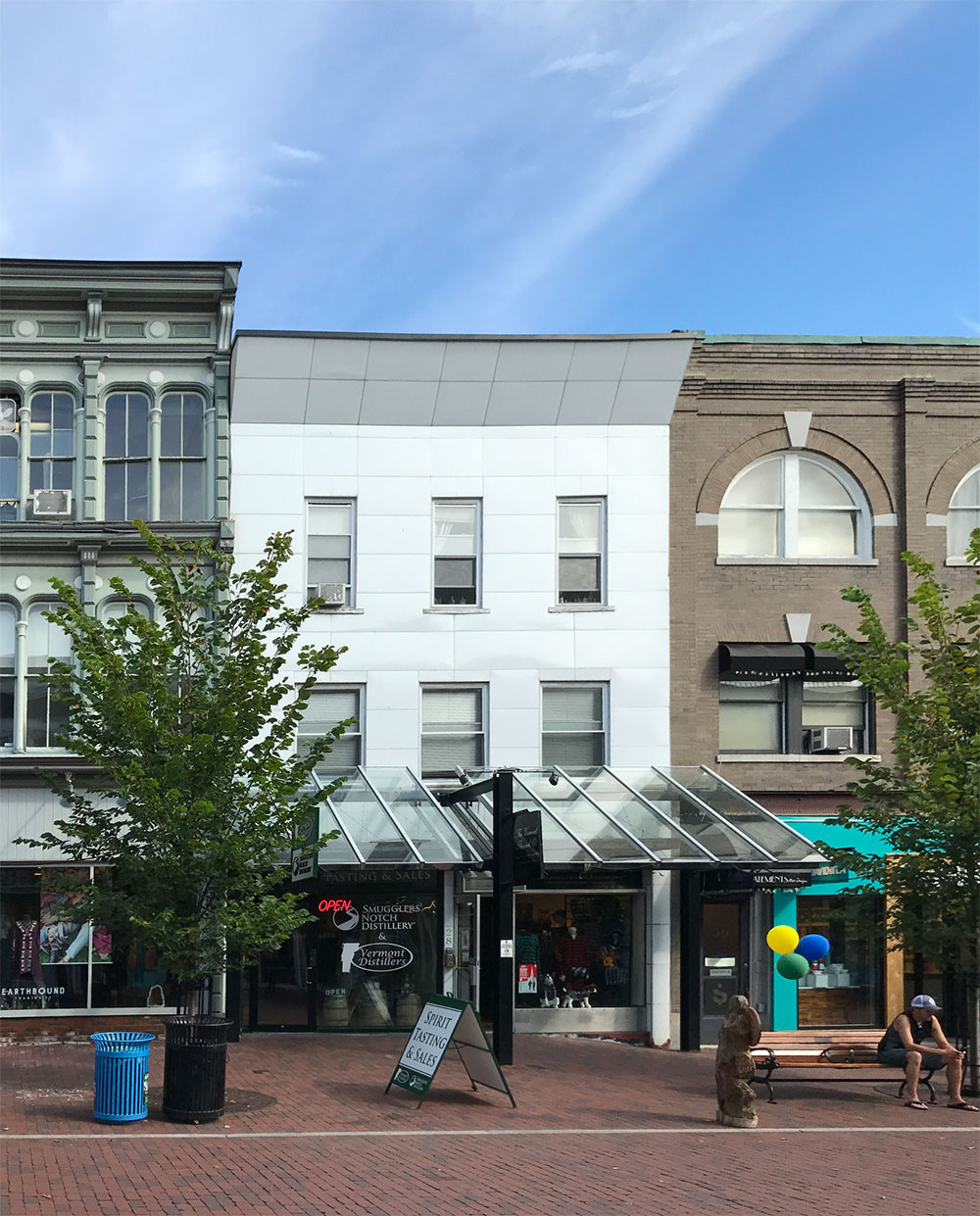
#28 Church Street
This demure 3-bay, white building may lack the eye-catching ornament of its Italianate neighbor, but #28 Church Street has a sophisticated, contemporary quality all its own. What began as a private residence and blacksmith shop in the 186024, evolved after the Civil War into a commercial building. Throughout the 1860s the plot housed a two-story market and in 1875 the foundation for the current building was erected. In 1889, the building was expanded through the addition of modern amenities and a third story.25 After changing hands several times throughout the early twentieth century, the edifice went through one final remodel in 1955 that resulted in the sleek International style façade that is still present today. The building’s white enamel exterior and simple geometry are characteristic of many mid-century, modern designs. The three-story building mirrored other buildings in the mid-block in the way that it served its residents. The bottom floor housed two businesses while the top floor was rented out as apartment space. The demand for this type of multi-use commercial building increased through the 1950s and beyond as the city of Burlington grew in population, industry and economy. Today the ground floor store front is shared by two local businesses, Vermont Distillers and the Vermont Flannel Company.
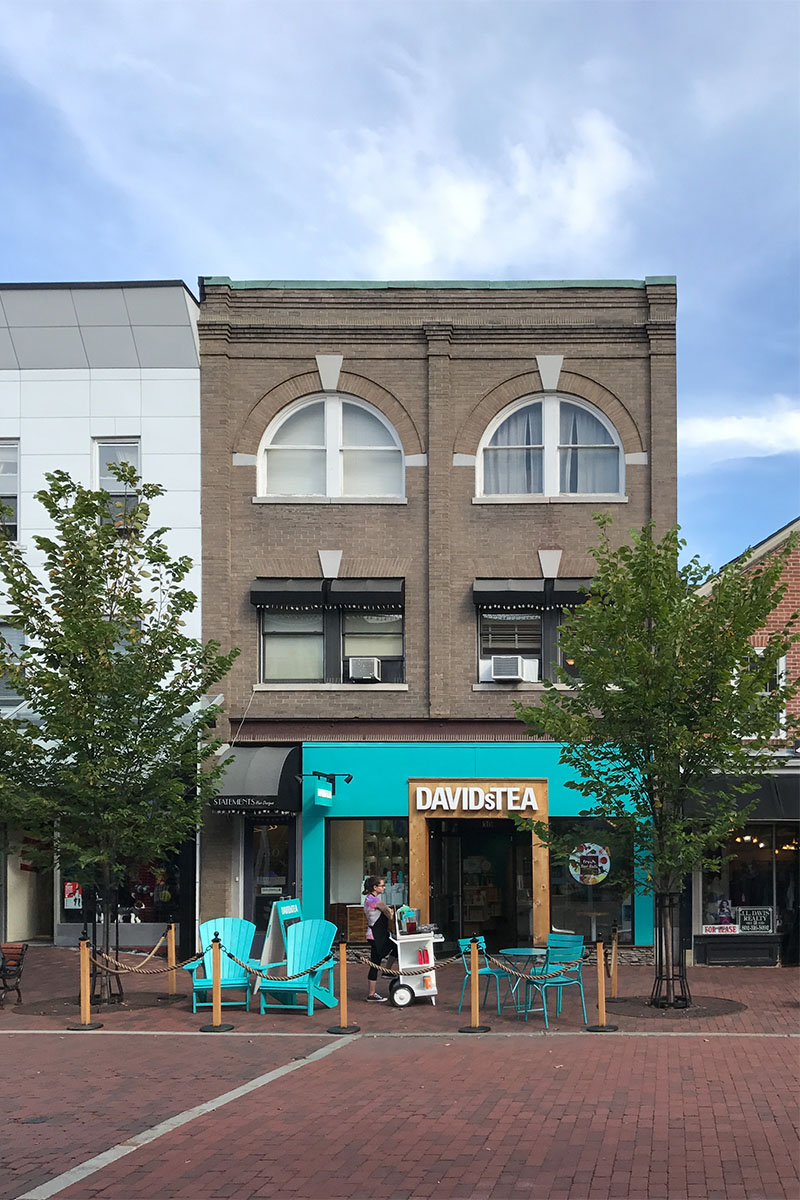
#30 Church Street
By the turn of the twentieth century, the lumber industry began to fall into decline. Burlington met that challenge by adapting the use of its lakefront property. First railroads and then petroleum played key roles in bolstering a more modern economy for Burlington and the surrounding areas. Coinciding with the changes on the waterfront, Upper Church Street continued its transformation into a bustling center for commerce. The Sanborn Fire Map from January 1900 illustrates just how built up the eastern side of the Top Block of Church Street had become.26 Other changes took place during the first quarter of the twentieth century that shaped Burlington as much, if not more than the decline in lumber. For Many Americans, the scourge of the first World War ushered in a transformed sense of the world, of nationalism, and of the cost of freedom. They wanted to get back to the lives, towns and people that they knew. Burlington, Vermont was no different. The population came together, went back to work, invested in local projects and endeavored to find creative new ways to secure a brighter future for their community.
In 1900, a Sanborn Fire map shows a modest two-story structure at #30 Church Street.27 However, the contemporary building at #30 Church Street was built at the height of World War I, in 1915. The building was commissioned by the prominent businessman Jeremiah W. O’Sullivan and designed by architect Frank Lyman Austin. Austin28 came from a line of accomplished builders and carpenters and developed a distinguished reputation for himself throughout Vermont during his lifetime. He was eventually so successful that he was appointed Vermont’s state architect.
Remembered as “O’Sullivan’s Block”, this Classical Revival commercial block is made of light colored brick and boasts large, half-moon windows on the building’s top floor and a more modern shop façade on the ground floor. On both stories the building’s windows are punctuated by prominent, contrasting keystones. From 1915 to 1922, the building was the site of O’Sullivan’s Pharmacy. Later known as Liggett’s Rexall Drugs, the building continued to serve the Burlington community in the following years. A large hand-painted sign for Liggett’s Drug Store can be seen in a photograph taken by Louis McAllister, looking north toward the Unitarian Church.29 After its time as a drug store, the building served as a retail shop for a variety of companies from the 1940s through the 1990s. It was during the 1990’s that the ground floor façade was remodeled, which accounts for the building’s current contemporary feel. Today the building is recognized for its colorful teal storefront and is the location of Statement’s Hair Design and David’s Tea.
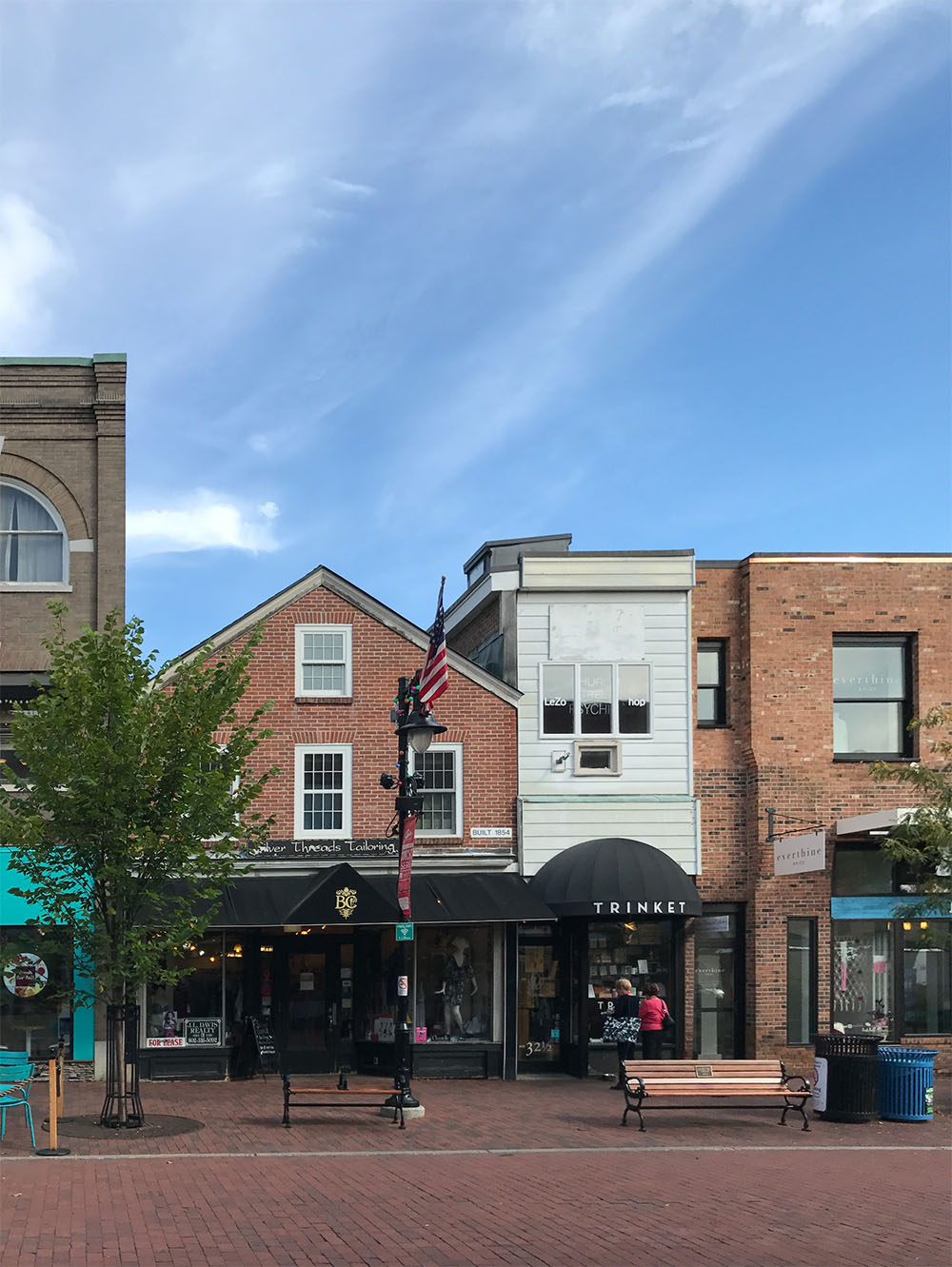
#32, 34, and 32 1/2 Church Street
This odd duo does at not quite match the height or opulence of their neighbors, but nonetheless they contribute to the narrative of the mid-block of Upper Church Street. Contrary to what may be guessed from its appearance, #32 is one of the oldest original buildings on Church Street. A small plaque on the front elevation displays the building’s vintage, built in 1854. It was historically given the name Warner House, in honor of Charles Warner, who purchased the property in 1862.30 Like all the other buildings on Church Street, # 32 changed owners and uses several times. During in the early twentieth century records show that the site housed a bakery, and later the Thomas and Company Clothing Shop. Thomas and Company, together with Sheppard and Hammel, remained in business at that location into the 1980s. The site continued to honor its long tradition of retail clothing sales until the fall of 2017, when Bertha Church’s Intimate Apparel moved to another location further down Church Street. The building’s upper floor, #34 Church Street, still houses Silver Threads Tailoring.
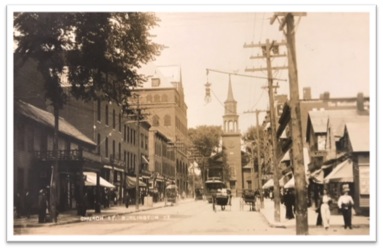
The buildings on Church Street were not the only things that went through several transformations. The street itself went through several evolutions, too. Two of McAllister’s photographs, taken only a few years apart from one another, from a similar angle, bring to light one of those changes. For a time, during the first half of the twentieth century, a trolley car ran the length of Church Street. The novel addition served shoppers, locals, and students and shuttled them from place to place. A 1924 article featured in the Burlington Free Press described a delay of construction on the trolley tracks. At the time, construction was halted in order to avoid chaos on Church Street during Fall Commencement week for the students at the University of Vermont.31 While it was a popular attraction, the trolley car was eventually removed. A second photograph taken by McAllister a few years later shows a much smoother road surface and a large partition separating the traffic lanes on Church Street.
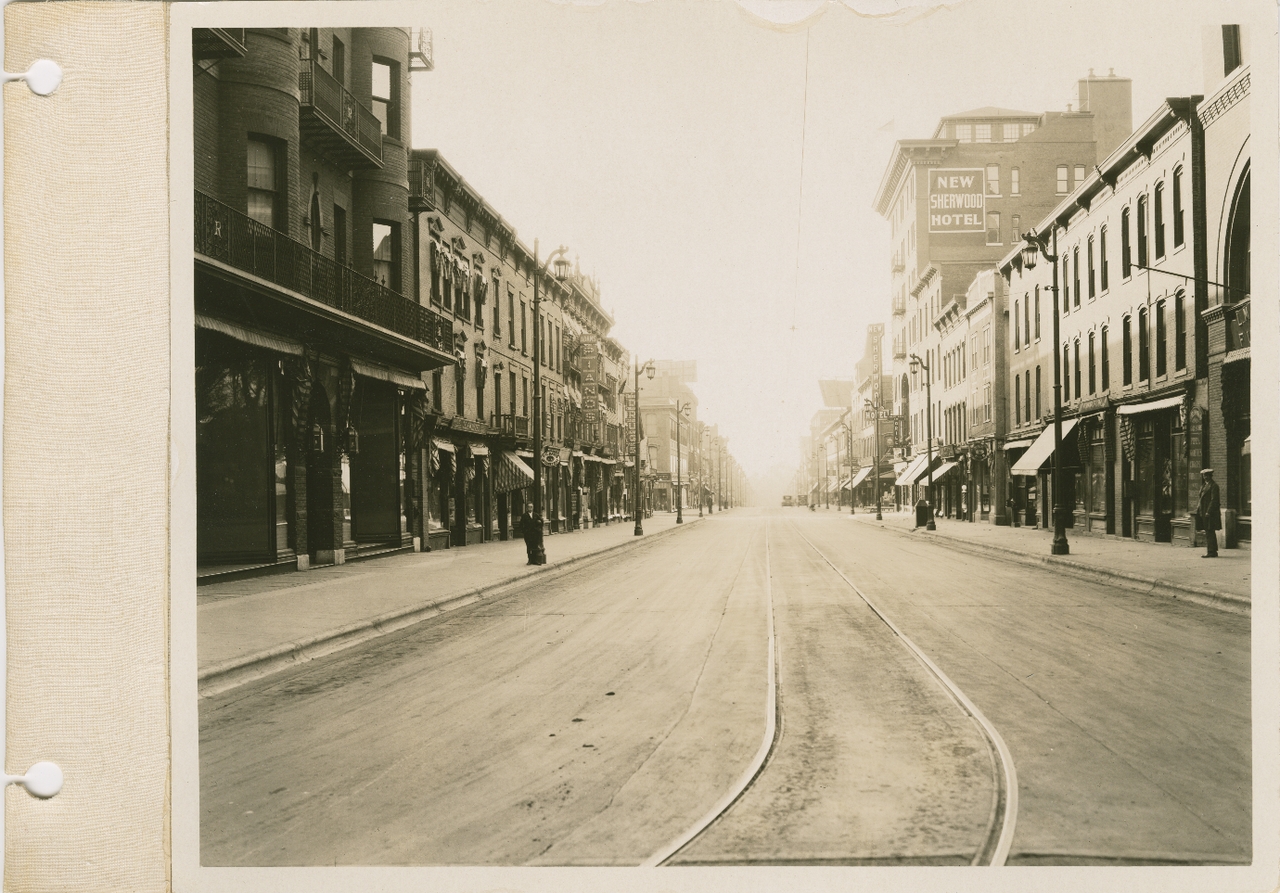
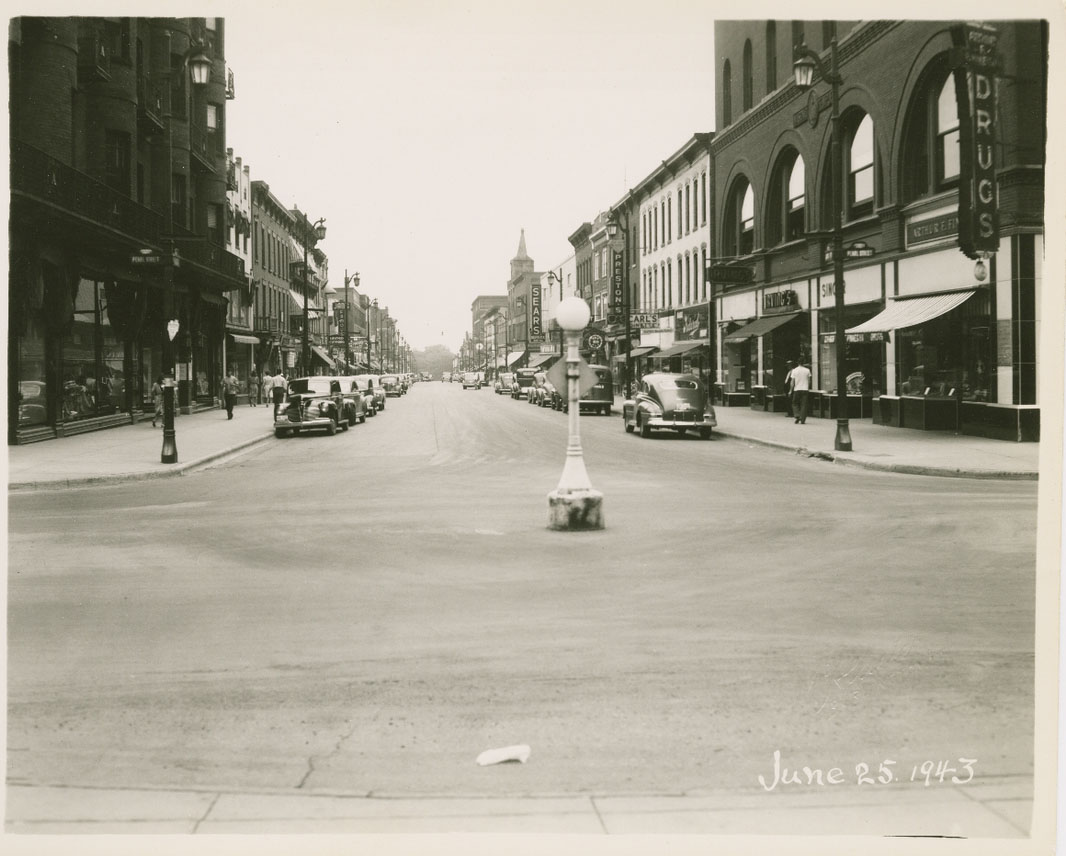
Other developments encouraged Church Street along its modern trajectory. There was a concerted effort in the 1970s, after the passage of the National Environmental Policy Act and other preservation and contemporary initiatives, to return Church Street to its original purpose, a pedestrian thoroughfare and shopping plaza. Modeled after an outdoor market in Copenhagen, the improvements to Church Street spanned the later quarter of the twentieth century. The labors were long, but the end result was a great success. Development and local investments have since blossomed. The Church Street Marketplace serves and embraces not only the local community and University of Vermont Students, but visitors as well. The marketplace hosts several festivals, concerts, parades and other spectacles throughout the year, rain or shine, that appeal to everyone.
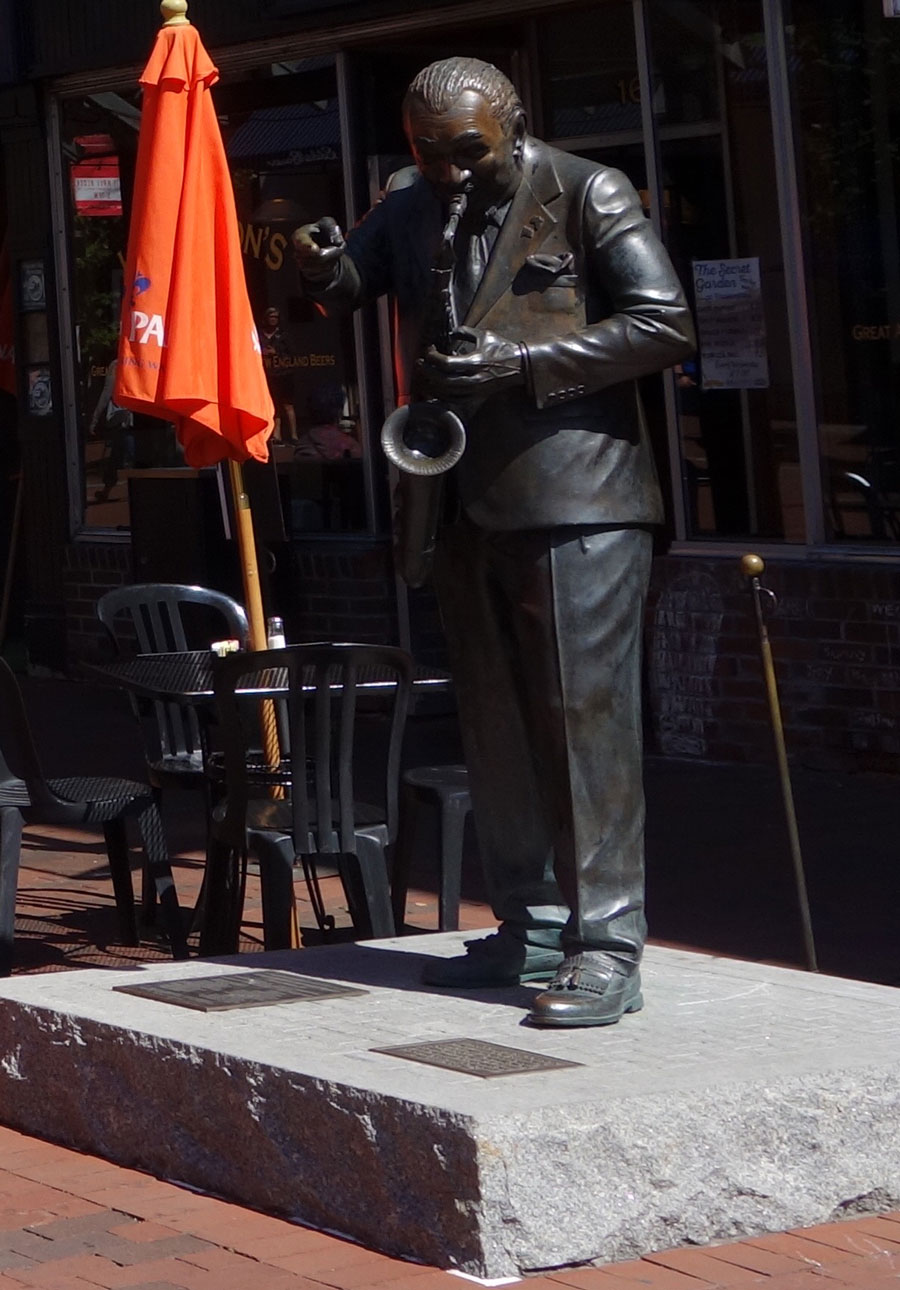
In order to maintain its distinction, Church Street Marketplace continues to evolve. One of the most recent embellishments to Church Street was made in 2010, near Halverson’s Upstreet Cafe. An article from the Burlington Free Press, dated June 3, 2006, described in vivid detail the newest, highly anticipated addition to the mid-block of Upper Church Street. A statue of beloved Burlington jazz musician Big Joe Burrell was to be placed near the very spot where he entertained countless guests for decades.32 It took longer than anticipated to raise the money required to install the statue. But finally, on June 4th, 2010, the opening night of Burlington’s 27th annual Discover Jazz Festival, Chris Sharp’s bronze sculpture of Big Joe Burrell was unveiled. Now, just in front of Halverson’s Upstreet Cafe, located at #16 Church Street, Big Joe and his saxophone stand in bronze, forever memorialized. The article described the statue as, “the image of a man who can do it all at once: lead, entertain, ad include others in his joyful world, and just play, play, play.”33 And indeed, the quintessential ambassador to visitors of Church Street, the likeness of the legendary performer is larger than life. His statue inspires joy and embodies the character of the lively community surrounding Church Street that Big Joe loved so well.
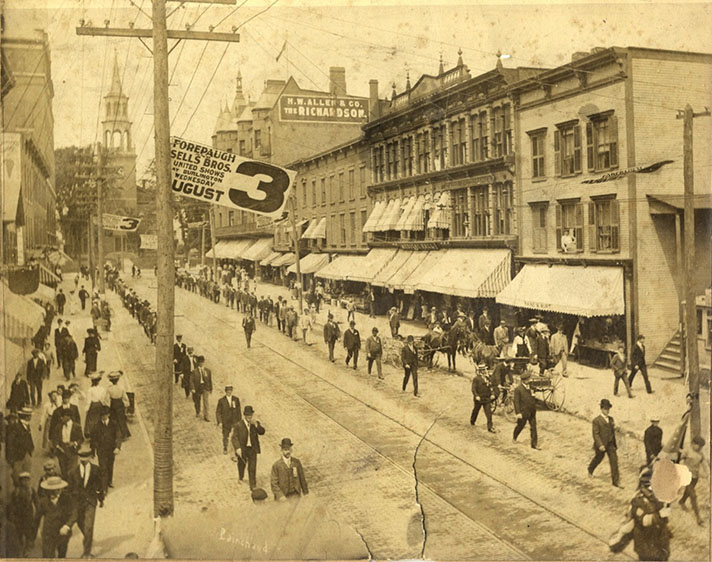
Church Street remains a treasured downtown destination for locals and tourists alike. It offers a unique blend of shopping, site-seeing, history, community and small-town charm that appeals to visitors of all ages. The brick-paved street is crowded with shade trees, park benches, food carts, restaurant patios and inspiring art. The emphasis placed by the city of Burlington on local businesses promises to continue to invigorate the local economy and maintain some of the long-standing traditions of Church Street since its conception. Visitors continue the legacy of Louis McAllister every time they take a picture of the marketplace. The colorful store fronts, glimpses of the glittering waterfront, small pockets of friends enjoying brunch, children enjoying a parade, buskers filling the street with music, all tell the story of Church Street’s unique character and continuing contribution to the city of Burlington and the state of Vermont.
NOTES
1. Ammi B. Young, Plan of Burlington Village. [map] Burlington, Vermont: 1830. Accessed through Special Collections, University of Vermont Library, October 21, 2017, http://cdi.uvm.edu/collections/item/Burlington_Young_1830.
2. “Vermont and the Civil War,” State of Vermont, accessed online November 1, 2017, http://historicsites.vermont.gov/vt_history/civil_war.
3. Joseph Auld, Picturesque Burlington: A Handbook of Burlington, Vermont and Lake Champlain, (Burlington: Free Press Association, 1894), 42-43.
4. J. J. Stoner, Birds eye view of Burlington and Winooski, VT. [map] Accessed through Special Collections, University of Vermont Library, October 5, 2017, http://cdi.uvm.edu/collections/item/Burlington_Map-1877birdseye.
5. Sanborn Map Company. Burlington 1869, Sheet 01. [map] New York: Sanborn Map Company, 1869. Accessed through Special Collections, University of Vermont Library, October 17, 2017, http://cdi.uvm.edu/collections/item/btvfi_1889_003.
6. “Frederick Billings”, National Park Service, accessed online November 1, 2017, https://www.nps.gov/mabi/learn/historyculture/frederickbillings.htm .
7. Ibid.
8. C. Wainwright. The Village of Burlington, Vt. [map] Burlington, Vermont: 1862. Accessed November 3, 2017, Special Collections, University of Vermont Library, http://cdi.uvm.edu/collections/item/Burlington_FreePres.
9. National Register of Historic Places Nomination: Church Street Historic District, Chittenden County, Vermont. Burlington, VT: Vermont Division for Historic Preservation, 2010.
10. Sanborn Map Company, Burlington 1889, Sheet 03. [map]. New York: Sanborn Map Company, Accessed November 3, 2017, Special Collections, University of Vermont Library,http://cdi.uvm.edu/collections/item/btvfi_1889_003
11. Ibid.
12. Louis L. McAllister, Burlington Streets: Church Street, Photographs, Box A4, Folder 04, Item 02, Accessed through Special Collections, University of Vermont Library, October 23, 2017 http://cdi.uvm.edu/collections/item/mcalA04F04i02.
13. National Register of Historic Places Nomination: Church Street Historic District, Chittenden County, Vermont. Burlington, VT: Vermont Division for Historic Preservation, 2010.
14. Sanborn Map Company, Burlington 1885, Sheet 03. [map]. New York: Sanborn Map Company, Accessed November 3, 2017, Special Collections, University of Vermont http://cdi.uvm.edu/collections/item/btvfi_1885_003.
15. “Sons Buy Store,” Burlington Free Press, (Burlington, VT) February 22, 1923.
16. National Register of Historic Places Nomination: Church Street Historic District, Chittenden County, Vermont. Burlington, VT: Vermont Division for Historic Preservation, 2010.
17. “Licenses Granted,” Burlington Free Press, (Burlington, VT), April 2, 1912.
18. “For Sale,” Burlington Free Press, (Burlington, VT), March 18, 1916.
19. National Register of Historic Places Nomination: Church Street Historic District, Chittenden County, Vermont. Burlington, VT: Vermont Division for Historic Preservation, 2010.
20. Ibid.
21. “Bacon’s New Block,” Burlington Free Press, (Burlington, VT), July 22, 1876.
22. National Register of Historic Places Nomination: Church Street Historic District, Chittenden County, Vermont. Burlington, VT: Vermont Division for Historic Preservation, 2010.
23. Louis L. McAllister, Burlington Streets: Church Street, Photographs, Box A4, Folder 04, Item 02, Accessed through Special Collections, University of Vermont Library, October 23, 2017 http://cdi.uvm.edu/collections/item/mcalA04F04i02.
24. C. Wainwright. The Village of Burlington, Vt. [map] Burlington, Vermont: 1862. Accessed November 3, 2017, Special Collections, University of Vermont Library, http://cdi.uvm.edu/collections/item/Burlington_FreePres.
25. National Register of Historic Places Nomination: Church Street Historic District, Chittenden County, Vermont. Burlington, VT: Vermont Division for Historic Preservation, 2010.
26. Sanborn Map Company, Burlington 1900, Sheet 17. [map]. New York: Sanborn Map Company, Accessed November 3, 2017, Special Collections, University of Vermont, http://cdi.uvm.edu/collections/item/btvfi_1900_017.
27. Ibid.
28. National Register of Historic Places Nomination: Church Street Historic District, Chittenden County, Vermont. Burlington, VT: Vermont Division for Historic Preservation, 2010.
29. Louis McAllister, Burlington Streets: Church Street, undated 1936, 1943.
30. National Register of Historic Places Nomination: Church Street Historic District, Chittenden County, Vermont. Burlington, VT: Vermont Division for Historic Preservation, 2010.
31. “City News,” Burlington Free Press, (Burlington, VT), June 16, 1924.
32. “Made in Big Joe’s Image: Vt. Artist’s Statue Meant to Portray Sax Man’s Spirit,” Burlington Free Press, (Burlington, VT), June 3, 2006.
33. Molly McGuire, “Big Joe Burrell Sculpture, Burlington,” Vermont Art Guide, accessed online November 1, 2017, http://vermontartguide.com/content/big-joe-burrell-sculpture/.
Historical Images
1. Ammi B. Young, Plan of Burlington Village. [map] Burlington, Vermont: 1830. Accessed through Special Collections, University of Vermont Library, October 21, 2017, http://cdi.uvm.edu/collections/item/Burlington_Young_1830.
2. Louis McAllister, Burlington Streets: Church Street. Louis L. McAllister Photographs, Box A4, Folder 04, Item 04. Accessed through Special Collections, University of Vermont Library, October 23, 2017, http://cdi.uvm.edu/collections/item/mcalA04F04i04.
3. J. J. Stoner, Birds eye view of Burlington and Winooski VT. [map] Accessed through Special Collections, University of Vermont Library, October 5, 2017, http://cdi.uvm.edu/collections/item/Burlington_Map-1877birdseye.
4. Sanborn Map Company. Burlington 1869, Sheet 01. [map] New York: Sanborn Map Company, 1869. Accessed through Special Collections, University of Vermont Library, October 17, 2017, http://cdi.uvm.edu/collections/item/btvfi_1889_003.
5. Sanborn Map Company. Burlington 1885, Sheet 03. [map] New York: Sanborn Map Company. Accessed through Special Collections, University of Vermont Library, October 23, 2017, http://cdi.uvm.edu/collections/item/btvfi_1885_003.
6. Louis L. McAllister, Burlington Streets: Church Street, Photographs, Box A4, Folder 04, Item 02, Accessed through Special Collections, University of Vermont Library, October 23, 2017 http://cdi.uvm.edu/collections/item/mcalA04F04i02.
7. Upper Church Street Postcard. University of Vermont Special Collections, Wilbur Collection.
8. Louis McAllister, Burlington Streets: Church Street. Louis L. McAllister Photographs, Box A4, Folder 04, Item 04. Accessed through Special Collections, University of Vermont Library, October 23, 2017, http://cdi.uvm.edu/collections/item/mcalA04F04i04.
9. Louis McAllister, Burlington Streets: Church Street, Louis L. McAllister Photographs, Box A4, Folder 04. Accessed through Special Collections, University of Vermont Library, October 23, 2017, Item 01, http://cdi.uvm.edu/collections/item/mcalA04F04i01
10. Postcard, circa 1900, Church Street. University of Vermont Special Collections.
